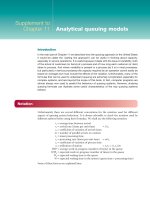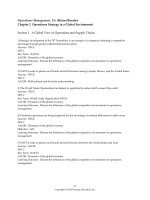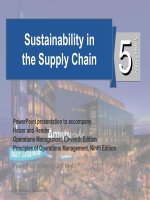Operations management heizer 6e ch14
Bạn đang xem bản rút gọn của tài liệu. Xem và tải ngay bản đầy đủ của tài liệu tại đây (640.86 KB, 84 trang )
Operations
Management
Chapter 14 –
Material Requirements
Planning (MRP) and ERP
PowerPoint presentation to accompany
Heizer/Render
Principles of Operations Management, 6e
Operations Management, 8e
© 2006
Prentice
Hall, Inc. Hall, Inc.
©
2006
Prentice
14 – 1
Outline
Global Company Profile: Collins
Industries
Dependent Inventory Model
Requirements
Master Production Schedule
Bills of Material
Accurate Inventory Records
Purchase Orders Outstanding
Lead Times for Each Component
© 2006 Prentice Hall, Inc.
14 – 2
Outline – Continued
MRP Structure
MRP Management
MRP Dynamics
MRP and JIT
Lot-Sizing Techniques
© 2006 Prentice Hall, Inc.
14 – 3
Outline – Continued
Extensions Of MRP
Closed-Loop MRP
Capacity Planning
Material Requirements Planning II
(MRP II)
MRP In Services
Distribution Resource Planning
(DRP)
© 2006 Prentice Hall, Inc.
14 – 4
Outline – Continued
Enterprise Resource Planning (ERP)
Advantages and Disadvantages of
ERP Systems
ERP in the Service Sector
© 2006 Prentice Hall, Inc.
14 – 5
Learning Objectives
When you complete this chapter, you
should be able to:
Identify or Define:
Planning bills and kits
Phantom bills
Low-level coding
Lot sizing
© 2006 Prentice Hall, Inc.
14 – 6
Learning Objectives
When you complete this chapter, you
should be able to:
Describe or Explain:
Material requirements planning
Distribution requirements planning
Enterprise resource planning
How ERP works
Advantages and disadvantages of
ERP systems
© 2006 Prentice Hall, Inc.
14 – 7
Collins Industries
Largest manufacturer of
ambulances in the world
International competitor
12 major ambulance designs
18,000 different inventory items
6,000 manufactured parts
12,000 purchased parts
© 2006 Prentice Hall, Inc.
14 – 8
Collins Industries
Four Key Tasks
Material plan must meet both the
requirements of the master schedule
and the capabilities of the production
facility
Plan must be executed as designed
Effective “time-phased” deliveries,
consignments, and constant review
of purchase methods
Maintain excellent record integrity
© 2006 Prentice Hall, Inc.
14 – 9
Benefits of MRP
1. Better response to customer
orders
2. Faster response to market
changes
3. Improved utilization of facilities
and labor
4. Reduced inventory levels
© 2006 Prentice Hall, Inc.
14 – 10
Dependent Demand
The demand for one item is related
to the demand for another item
Given a quantity for the end item,
the demand for all parts and
components can be calculated
In general, used whenever a
schedule can be established for an
item
MRP is the common technique
© 2006 Prentice Hall, Inc.
14 – 11
Dependent Demand
Effective use of dependent demand
inventory models requires the
following
1.
2.
3.
4.
5.
© 2006 Prentice Hall, Inc.
Master production schedule
Specifications or bill of material
Inventory availability
Purchase orders outstanding
Lead times
14 – 12
Master Production Schedule
(MPS)
Specifies what is to be made and when
Must be in accordance with the aggregate
production plan
Aggregate production plan sets the
overall level of output in broad terms
As the process moves from planning to
execution, each step must be tested for
feasibility
The MPS is the result of the production
planning process
© 2006 Prentice Hall, Inc.
14 – 13
Master Production Schedule
(MPS)
MPS is established in terms of specific
products
Schedule must be followed for a
reasonable length of time
The MPS is quite often fixed or frozen in
the near term part of the plan
The MPS is a rolling schedule
The MPS is a statement of what is to be
produced, not a forecast of demand
© 2006 Prentice Hall, Inc.
14 – 14
Master Production Schedule
(MPS)
Can be expressed in any of the
following terms:
A customer order in a job shop (maketo-order) company
Modules in a repetitive (assemble-tostock) company
An end item in a continuous (make-tostock) company
© 2006 Prentice Hall, Inc.
14 – 15
Aggregate
Production Plan
Months
Aggregate Production Plan
(shows the total
quantity of amplifiers)
Weeks
1
January
February
1,500
1,200
2
3
4
5
6
7
8
Master Production Schedule
(shows the specific type and
quantity of amplifier to be
produced
240 watt amplifier
150 watt amplifier
75 watt amplifier
100
100
500
100
500
300
100
450
450
100
Figure 14.2
© 2006 Prentice Hall, Inc.
14 – 16
The Planning Process
Production
Capacity
Inventory
Marketing
Customer
demand
Procurement
Supplier
performance
Management
Return on
investment
Capital
Finance
Cash flow
Human resources
Manpower
planning
Aggregate
production
plan
Master production
schedule
Engineering
Design
completion
Change
production
plan?
Figure 14.1
© 2006 Prentice Hall, Inc.
14 – 17
The Planning Process
Master production
schedule
Change
requirements?
Change
master
production
schedule?
Material
requirements plan
Change
capacity?
Capacity
requirements plan
No
Realistic?
Yes
Is capacity
plan being
met?
Is
execution
meeting the
plan?
Execute capacity
plans
Execute
material plans
Figure 14.1
© 2006 Prentice Hall, Inc.
14 – 18
Focus for Different
Process Strategies
Make to Order
(Process Focus)
Number of
end items
(Product Focus)
Schedule modules
Schedule orders
Number of
inputs
Examples:
© 2006 Prentice Hall, Inc.
Stock to Forecast
Schedule finished
product
Typical focus of the
master production
schedule
Figure 14.3
Assemble to Order
or Forecast
(Repetitive)
Print shop
Machine shop
Fine-dining restaurant
Motorcycles
Autos, TVs
Fast-food restaurant
Steel, Beer, Bread
Lightbulbs
Paper
14 – 19
MPS Examples
For Nancy’s Specialty Foods
Gross Requirements for Crabmeat Quiche
Day
Amount
6
50
7
8
100
9
47
10
60
11
12
110
13
75
14 and so on
Gross Requirements for Spinach Quiche
Day
Amount
7
8
9
100 200 150
10
11
12
60
13
75
14
15
100
16 and so on
Table 14.1
© 2006 Prentice Hall, Inc.
14 – 20
Bills of Material
List of components, ingredients,
and materials needed to make
product
Provides product structure
Items above given level are called
parents
Items below given level are called
children
© 2006 Prentice Hall, Inc.
14 – 21
BOM Example
Level
Product structure for “Awesome” (A)
0
A
1
2
3
Std. 12” Speaker kit w/
C(3) amp-booster
B(2) Std. 12” Speaker kit
E(2)
D(2)
F(2) Std. 12” Speaker
E(2)
Packing box and
installation kit of wire,
bolts, and screws
booster assembly
G(1)
D(2)
Amp-booster
12” Speaker
© 2006 Prentice Hall, Inc.
12” Speaker
14 – 22
BOM Example
Level
Product structure for “Awesome” (A)
0
A
1
2
3
D(2)
Part B: 2 x number of As =
(2)(50) =
100
Std. 12” Speaker300
kit w/
C:
3
x
number
of
As
=
(3)(50)
=
BPart
Std.
12”
Speaker
kit
C
(2)
(3)
amp-booster
Part D: 2 x number of Bs
+ 2 x number of Fs = (2)(100) + (2)(300) = 800
Part E:
E(2) 2 x number of Bs
E(2)
F(2) Std. 12” Speaker
booster
+ 2 x number of Cs = (2)(100) + (2)(150)
= assembly
500
Part F: 2 x number of Cs =
(2)(150) =
300
Packing box and
Part G: 1installation
x numberkitofofFs
=
(1)(300)
300
wire,
G(1) =
D(2)
bolts, and screws
Amp-booster
12” Speaker
© 2006 Prentice Hall, Inc.
12” Speaker
14 – 23
Bills of Material
Modular Bills
Modules are not final products but
components that can be assembled
into multiple end items
Can significantly simplify planning
and scheduling
© 2006 Prentice Hall, Inc.
14 – 24
Bills of Material
Planning Bills
Created to assign an artificial parent
to the BOM
Used to group subassemblies to
reduce the number of items planned
and scheduled
Used to create standard “kits” for
production
© 2006 Prentice Hall, Inc.
14 – 25









